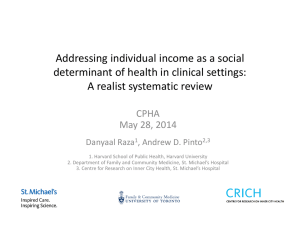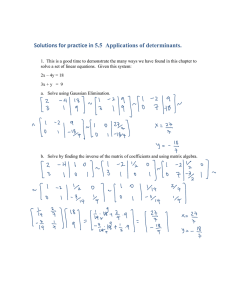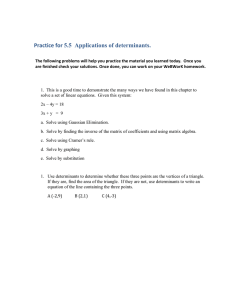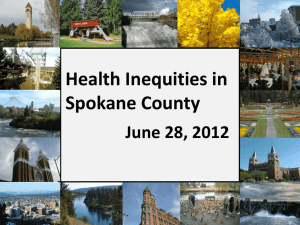Seeing beyond the formal health care Gloria DeSantis, PhD Research Associate, SPHERU
advertisement
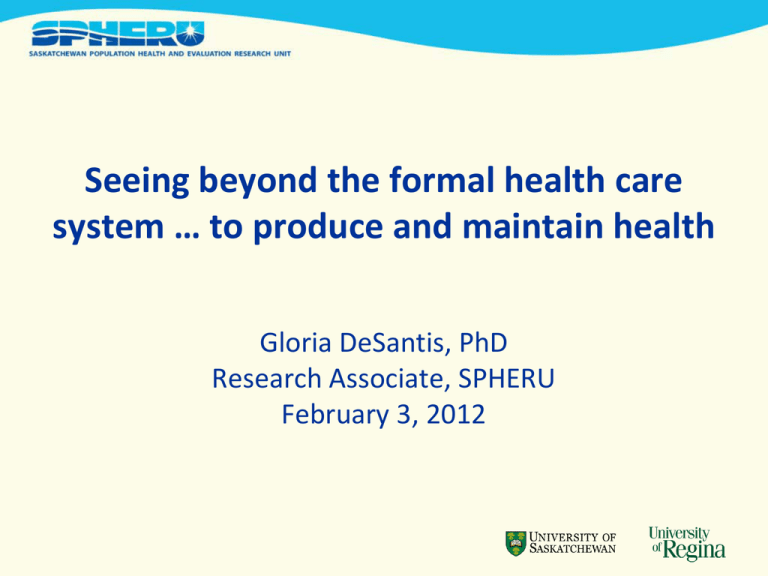
Seeing beyond the formal health care system … to produce and maintain health Gloria DeSantis, PhD Research Associate, SPHERU February 3, 2012 Overview 1. What is SPHERU? 2. Seeing beyond ... a) health & population health b) social determinants of health c) community-based organizations (CBOs) 3. Introduction of research project 4. Emphasis on methods and challenges faced 5. Summary and questions What do we do at SPHERU? Vision Working with communities and policy makers to improve the health of Saskatchewan people. Mission The promotion of health equity by understanding and addressing population health disparities through policy-relevant research. Our Research • examines intersectoral implications for the implementation of population health interventions • contributes to knowledge translation through the synthesis of theoretical and methodological innovations • applies novel approaches, research designs, and frameworks in studies • increases capacity of Saskatchewan researchers, academics, community partners and governments in research, knowledge translation and policy development and innovation Research Themes History of Health Inequities • • Northern & Aboriginal Health • • explores the role of culture as a determinant of health develops culturally relevant definitions of health and appropriate health indicators Healthy Children • Rural Health • • explores rurality as a determinant of health involves local partners to address inequities in health-determining conditions examines how health in Saskatchewan has changed over the last century and has varied among communities provides lessons for modern policy makers by understanding historical health outcome disparities creates understanding of how various contexts – family, neighbourhood social and physical environments, schools – play a role in determining children’s health and development Intervention Research • • promotes capacity by engaging in policy and program evaluation impacts policy by involving policy makers and addressing specific health disparities Knowledge Transfer and Exchange • collaborative research projects • research findings in plain language (e.g., newsletters) • videos • toolkits of findings for communities to use • research networks for knowledge exchange • conferences and forums • expert dialogues Let us situate SPHERU’s work & the current research project This presentation offers a tiny glimpse beyond this formal health system • Historically, major advances in health status resulted from broad social reforms in communities (Hofrichter 2003; Green & Labonte 2008) - Virchow’s work in 1847 • Most of what keeps us healthy lies outside the formal health care system (Evans 2003; Lalonde 1974; Marmor et al 1994; Orsini 2007) A broad definition of health “Health is a state of complete physical, social and mental well-being and not merely the absence of disease or infirmity …” (WHO 1998, p. 11) - important to add “spiritual” as per Aboriginal communities’ conceptualizations of health (Loppie Reading 2009) Defining population health Determinants of health + - sustainable ecosystems - built environments - community supports - social equity e.g. poverty - prosperity - human biology - personal health behaviour - health services Processesof-change over the life course Population health status: - education, life long learning - governance - positive - negative - disparities (inequities) (volunteerism, engagement, participation, voter turnout, etc.) (see also Hancock et al. 2000; SPHERU 2002) More specifically, social determinants of health are: • • • • • • • • • • Socio-economic circumstances (e.g., income) Stress Early life Social exclusion All of these Work influence Unemployment health Social support Addiction Food Transport (Wilkinson & Marmot 2003) Research on social determinants shows: • In general, some groups have worse health status than others – people who live in poverty – many First Nations peoples – many immigrants & refugees – people with disabilities – single moms with children … etc. • This reveals inequities So what is health equity? Equity = fairness Inequities are differences across groups which are unfair, unnecessary, and avoidable (Edwards 2009) Some groups of people sleep here … … while others sleep here. Groups who live, work and play in poor social conditions, have poorer health (Whitehall II Study, Wilkinson & Marmot 2003, WHO 2008) • Dynamics of SDOH are complex • Effects of SDOH mediated by other factors like health care, air quality, etc. (Danaher 2011) Also, beyond the formal health care system are social service CBOs • Health/well-being of communities depends on variety actors in myriad environments (Bolen & Ramsey 2007, Raphael 2004) • Role for social service, community-based organizations (CBOs) in facilitating health/well-being (Bell 2009, Hall & Banting 2000, DeSantis 2008) Social service CBOs defined • institutionally separate from government and the private sector • have an organizational structure • exist to serve a public benefit • are self governing • do not distribute profits to members and • depend on volunteers to varying degrees (Government of Canada, 2002; Hall & Banting, 2000) Examples of social service CBOs Indian Metis Christian Fellowship Social service CBO functions in society (Danaher 2011, DeSantis 2008) • Provide programs & services • Engage their communities, build capacity, trust, etc • Advocate for healthier public policy at multiple levels • Inspire innovative approaches • Encourage cross-sectoral collaboration & work across government silos Support, defend and offer a safety net for the most vulnerable Quick check-in regarding where we’ve just come from • Defined health & population health • Defined social determinants of health (SDOH) • Defined social service, community-based organizations (CBOs) Now let us consider the specifics of a SPHERU research project: Seeing beyond the formal health care system … to produce health with emphasis on the methods, not results Introduction to the project • Regina Regional Intersectoral Committee (RIC) recognized importance of SDOH • RIC Community Support Team decided to survey Regina organizations, conducted the survey (2009) - CBOs, quasi-government, governments - this presentation focuses on CBO data only • SPHERU became involved in data analysis phase Research project objectives a) To document SDOH* in Regina organizations b) To raise awareness of SDOH among organizations c) To use collected data to facilitate more integrative & collective action d) To create a publicly accessible inventory * RIC used the term “determinants of community wellbeing” (DCWB) instead of SDOH Method of data collection - overview • Semi-structured survey research - qualitative & quantitative elements • Convenience sample using RIC member e-lists (N=169) - easy access for participants • On-line survey using “Survey Monkey” - free, easy to create, easy for respondents Method of data collection - sample What organizations comprise the sample? • 37 CBOs reported on 77 initiatives (22% response rate) • 75% offer services at city scale • Almost equal split between agencies operating on – < $100,000/year, – $100,000 to $499,999/year, – >$500,000/year • 70% agencies had < 25 staff Method of data collection - survey On-line survey: • 5 organization questions - mandate, # employees, geographic focus, annual operating budget, sources of funding • 12 questions about DCWB initiatives – mandate, target populations, partners, key activities, funding amount and sources, DCWB priority areas … • No confidentiality or anonymity issues Method of data collection - survey Example questions Method of data collection - survey Example questions Method of data collection - survey Example questions Note: determinants of community well-being = determinants of health Method of data analysis Primary method used was content analysis: • Data cleaning • Frequency counts, percentages, “sort” function using excel - bar graphs - diagramming and mapping • Summarization • Explication Methods – some challenges At times we wanted to pretend the data had never been collected: 1. Sample and universe – generalizability? 2. Respondents – front-line versus managers 3. Survey questions - mutually exclusive categories? - on-line thus no opportunity to clarify - check boxes versus open questions 4. “Survey Monkey” data stored in American co. Results - spatial distribution of sample Results – determinants of community well-being (or SDOH) Results - activities offered by 77 initiatives Results – sources of funding Results – amount of funding • 44% (N=34) initiatives had annual operating budget < $50,000 - one funding source was most common - donations & fundraising most common • 31% (N=24) initiatives had annual operating budgets > $200,000 - two or three funding sources most common - donations, fundraising & provincial funding common Results – service partnerships Summary and lingering questions 1. CBOs are working on variety of SDOH - social inclusion & social safety net most common - most frequently cited activities were social supports, community engagement & education - focus on “discriminated” groups BUT, what are actual impacts? 2. Income and its inequitable distribution least cited SDOH Poverty exists in Saskatchewan, but there’s no provincial strategy for its elimination? Summary & lingering questions 3. a) SDOH initiatives funded most frequently by donations and fundraising/earned income b) largest number had very small budgets Are we as a society comfortable with acts of charity as part of a SDOH funding model? 4. In general, CBOs had multiple partners, thus a degree of service integration exposed BUT is this enough to meet the goal of crosssectoral, collaborative, integrated planning required to reduce health inequities? In closing ... • Communities are central places for health production and maintenance; there is plenty of evidence. • This research begs many more questions … let us see beyond the formal health care system to work toward policy and program answers (see SPHERU Lancet article for a start)! Acknowledgements • the people with whom I work and volunteer who are committed to changing social and health inequities through CBOs … they keep me going! • colleagues Carla Bolen (formerly RQHR) & Wendy Stone (Regina Police Service), my research partners • SPHERU colleagues • Fellowship funding from Saskatchewan Health Research Foundation THANK YOU FOR LISTENING - I LOOK FORWARD TO YOUR QUESTIONS!
